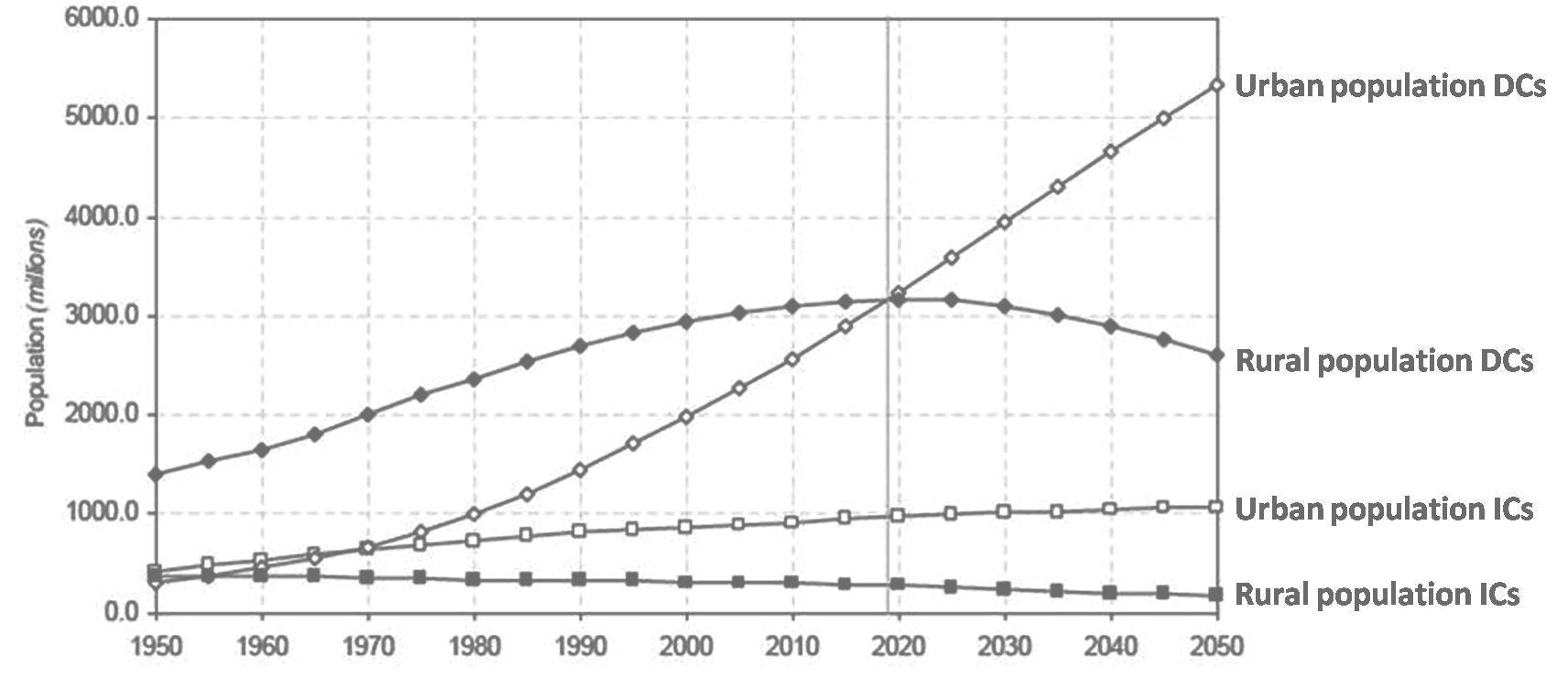We
live in a rapidly urbanizing world and since mid-2007 over half of us live in
urban areas. However, in developing countries the real phenomenon is actually
'periurbanization' − the relentless growth of periurban slums, which is expected to continue unabated for the foreseeable future.
Current world population given here (date in mm/dd/yy format).
Current world urban population given here.
See chart at the bottom of this page.
80% of world population will soon be in urban areas
(InfoChange News & Features,
India, 2007)
Maps from Worldmapper: World Population 2000 World Population 2050
City Living Urban Slums
"Out of every 100 persons added to the population in the coming
decade, 97 will live in developing countries" (Hania Zlotnik, Director, UN Population Division, 2005).
Planning Sustainable Cities − Global Report on Human Settlements 2009
(UN-Habitat, 2010)
Health and the urban environment: revolutions revisited
(iied, 2009)
Population Reports: Meeting the Urban Challenge (Johns Hopkins
University, 2002)
India's urban poor are being squeezed for living space (The
Guardian, 2008)
Our cities, our health, our future: Acting on social
determinants for health equity in urban
settings (WHO Kobe Centre, 2007)
State of the World 2007: Our Urban Future (Worldwatch
Institute, 2008). University of Leeds Library catalogue entry.
"Although mega-cities have received most of the attention,
conditions in smaller urban areas call for even greater consideration. Contrary to general belief, the bulk of urban
population growth is likely to be in smaller cities and towns, whose
capabilities for planning and implementation can be exceedingly weak. Yet the worldwide process of decentralizing
governmental powers is heaping greater responsibility on them. As the population of smaller cities increases,
their thin managerial and planning capacities come under mounting stress. New ways will have to be found to equip them
to plan ahead for expansion, to use their resources sustainably and to deliver essential services" [State
of World Population 2007, Introduction]. University of Leeds Library catalogue entry.
Trends in urban and slum indicators across developing world
cities, 1990–2003 (Habitat International,
2008)
Concentration without Congestion: Policies for an Inclusive Urbanization (Chapter 7 of WDR 2009)
Book:
Century of the City: No Time to Lose (Rockefeller Foundation, 2008) − the link gives details of how to
apply for a free copy. See especially Chapter 4 "Urban health: Learning from systems that work".
State of World
Population 2007: Unleashing the Potential of Urban Growth (UNFPA, 2007) ULL
catalogue entry.
►
Multimedia
presentation
The Transition to a Predominantly Urban World and its
Underpinnings (IIED, 2007)
The State of the World's Cities 2006/7 (UN-Habitat, 2006) ULL
catalogue
entry
The Urban Poor in Latin America
(World Bank, 2005) − read chapter 3 “Keeping a Roof over One’s Head: Improving
Access to Safe and Decent Shelter” and chapter 5 “Keeping Healthy in an Urban Environment:
Public Health Challenges for the Urban Poor” (chapter 5 has good info. on urban health disparities).
World Urban Forum III (Vancouver, June 2006) Background paper
The World Goes to Town: A
Special Report on Cities (The
Economist, 2007)
Listen here.
The Challenge of Slums (UN Habitat Global Report on Human
Settlements, 2003)
Global Experiences on Expanding Services to the Urban Poor
(WSP, 2009)
See also: Slum Upgrading Water Conservation
Global environmental resources versus world
population growth (Ecol. Econ., 2006)
Living in the City: Challenges and Options for the Urban
Poor (International Food Policy Research Institute, 2002) − a food-security perspective.
Urban Health Updates (Environmental Health at USAID)
Urban Health
Information (Environmental Health Project/USAID webpage)
Urban
Growth Management Initiative: Causes and Consequences of Urban Expansion (Williams College, website)
World population 1950−2050
Most growth is occurring and will continue to occur in urban areas of developing countries, but in reality it will be in periurban areas.

